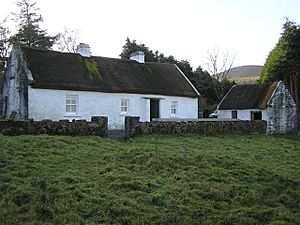Seán Mac Diarmada facts for kids
Quick facts for kids
Seán Mac Diarmada
Seán MacDermott |
|
|---|---|
 |
|
| Born | 27 January 1883 Kiltyclogher, County Leitrim, Ireland |
| Died | 12 May 1916 (aged 33) Kilmainham Gaol, Dublin, Ireland |
| Allegiance | Irish Republican Brotherhood Irish Volunteers |
| Years of service | 1913–1916 |
| Rank | Supreme Council IRB Military Committee IRB |
| Battles/wars | Easter Rising |
| Other work | Educator, principal, barrister, republican activist, poet |
Seán Mac Diarmada (born January 27, 1883 – died May 12, 1916), also known as Seán MacDermott, was an important Irish leader. He worked to make Ireland an independent country. He was one of the seven main leaders of the Easter Rising in 1916.
Seán helped plan the Rising as part of a group called the Irish Republican Brotherhood (IRB). He was also the second person to sign the Proclamation of the Irish Republic. This document declared Ireland's independence. He was executed for his role in the Rising when he was 33 years old.
Seán grew up in the countryside of County Leitrim. He joined many groups that supported the Irish language, Irish culture, and Irish independence. These groups included the Gaelic League and the Ancient Order of Hibernians. He also worked for Sinn Féin and later managed a newspaper called Irish Freedom.
Early Life and Activism
Seán Mac Diarmada was born John MacDermott in Corranmore, near Kiltyclogher in County Leitrim. His father, Donald McDermott, was also involved in the IRB. The area where Seán grew up showed many signs of Ireland's past struggles. There were old sweat-houses, Mass rocks from times when Catholics were persecuted, and empty homes from the Great Famine.
Seán went to school at Corradoona national school. In 1908, he moved to Dublin. By then, he was already very involved in Irish nationalist and cultural groups. These included Sinn Féin, the Irish Republican Brotherhood (IRB), the Ancient Order of Hibernians, and the Gaelic League.
He quickly rose through the ranks of the IRB. He became a member of its Supreme Council and later its secretary. At first, he didn't want to join the IRB because the Catholic Church did not approve of it. But his friend Bulmer Hobson convinced him to join.
In 1910, Seán became the manager of a newspaper called Irish Freedom. He started this newspaper with Bulmer Hobson and Denis McCullough. He also became a national organizer for the IRB. An older Irish nationalist, Tom Clarke, became his mentor. They became very close friends. Soon after, Seán got polio, which made him need to use a cane to walk.
Mac Diarmada and Clarke supported the workers during the 1913 Dublin Lockout. This was a major strike in Dublin.
In November 1913, Seán Mac Diarmada was one of the first members of the Irish Volunteers. He worked to make sure the IRB had control over this group. In May 1915, he was arrested in Tuam, County Galway. He was arrested for speaking against joining the British Army during World War I.
The Easter Rising
After he was released from prison in September 1915, Seán joined a secret group. This group was the Military Committee of the IRB. They were in charge of planning the Easter Rising. Seán Mac Diarmada and Tom Clarke were the main people behind the plan. In 1914, Seán said that the Irish spirit would die if a "blood sacrifice" was not made soon.
Because of his polio, Seán Mac Diarmada did not take part much in the actual fighting during Easter week. He stayed at the headquarters in the General Post Office (GPO). He was one of the leaders of the new Irish government declared during the Rising.
After the Rising ended, Seán almost escaped capture. He tried to blend in with the many prisoners. But he was recognized by Daniel Hoey, a police officer. After a quick trial on May 9, Seán Mac Diarmada was executed by a firing squad. This happened in Kilmainham Gaol on May 12, when he was 33 years old.
Later, in September 1919, Daniel Hoey was shot and killed. The British officer who ordered Seán's execution was also killed. These actions happened during the Irish War of Independence.
Seán Mac Diarmada had been writing letters to a woman named Nell Ryan. In his last letter, he wrote that she would have been his wife if he had lived. Nell's sisters, Min and Phyllis, had helped carry messages to the GPO during the Rising. They also visited Seán in Kilmainham Gaol before he was executed. Min, who helped start a women's group called Cumann na mBan, later escaped to America.
Before his execution, Seán Mac Diarmada wrote, "I feel happiness the like of which I have never experienced. I die that the Irish nation might live!”
Remembering Seán Mac Diarmada
Many places are named after Seán Mac Diarmada. Seán McDermott Street in Dublin is named in his honor. So is Sligo Mac Diarmada railway station in Sligo. Páirc Seán Mac Diarmada, a stadium for Irish sports, is in Carrick-on-Shannon, County Leitrim.
A tall building in Ballymun, Dublin, called Sean MacDermott tower, was also named after him. It was taken down in 2005. In his hometown of Kiltyclogher, a statue with his last words stands in the village center. His childhood home is now a special National Monument. The building that holds the national bus station in Dublin is called Áras Mhic Dhiarmada.
See also
 In Spanish: Seán Mac Diarmada para niños
In Spanish: Seán Mac Diarmada para niños
- List of people on stamps of Ireland
- List of members of the Irish Republican Brotherhood



